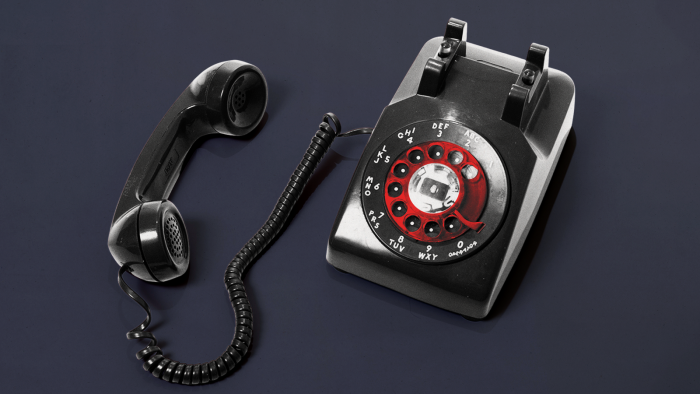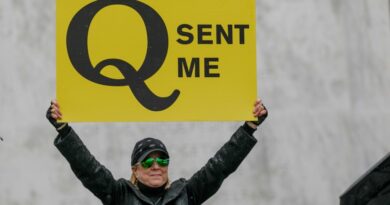Why It’s So Hard To Gauge Support For QAnon

Just how many Americans believe in the QAnon conspiracy? Recent polling from June shows it’s around 15 percent. But wait, a poll from last October found it was 7 percent. But even that is high compared to a rolling survey that pegged it at 4 percent earlier this month.
Why the disparity? Maybe, in an attempt to minimize the power of QAnon, a secretive clique of polling elites signed a contract with Satan and Marina Abramović to offer wildly different survey results … or maybe it’s just difficult to poll about QAnon.
As much as QAnon feels like a distinctly modern phenomenon, much of its lore is rooted in conspiracy theories that have existed for decades or, in some cases, centuries (the core one is that a global cabal of elites is running a Satanic child sex-trafficking and cannabilism ring). It’s part of what has helped QAnon gain as much traction as it has, a kind of big-tent conspiracy movement that combines aspects of many different out-there beliefs. But it’s also what makes it hard to measure.
What if someone thinks a few Q ideas sound plausible? Should a poll consider them a “believer?” What about Americans who endorse QAnon beliefs without realizing they’re associated with QAnon?
Pollsters have strategies for solving these dilemmas, but it’s hard to solve all of them at once. Accounting for one dilemma — say, avoiding the term “QAnon” so you don’t scare off people who are hesitant about sharing their affiliation — opens the door for another (capturing people who aren’t affiliated with QAnon at all). As a result, each individual poll asks very different questions and, ultimately, measures different things.
Consider a recent poll from PRRI. It asked Americans whether they agreed with three separate statements, each a part of the QAnon belief system, but it didn’t mention QAnon by name. Fifteen percent of Americans agreed with the statement “the government, media, and financial worlds in the U.S. are controlled by a group of Satan-worshipping pedophiles who run a global child sex trafficking operation.” That statement is the central tenet of QAnon, but it’s also not a belief unique to the movement. Fears about Satan-worshipping pedophiles predate QAnon entirely, so belief in that statement isn’t limited to people who follow — or have even heard of — Q, according to Mary deYoung, a professor emeritus of sociology at Grand Valley State University in Michigan. DeYoung has studied the so-called “Satanic panic,” the inaccurate belief popular in the 1980s that Satanic ritual abuse of children was widespread in this country. A 1986 ABC News poll found that 63 percent of Americans believed members of religious cults had “too much influence in this country,” and 54 percent of America thought there should be laws against Satan worship, per a 1987 Williamsburg Charter Foundation poll.
The other statements that PRRI polled, about a “storm coming” to “sweep away elites in power,” (20 percent) and that “patriots may have to resort to violence” (15 percent) aren’t unique to QAnon, either. The “storm” prediction mimics the apocalyptic language of evangelical Christianity, and resorting to violence would be endorsed by any number of right-wing militia or extremists.
Natalie Jackson, PRRI’s director of research, said the firm had existing conspiracy theories in mind when designing the survey and carefully worded the statements to match what they found in QAnon sources. She also said that QAnon’s breadth of conspiratorial topics is partly why PRRI focused on the beliefs themselves, rather than asking respondents to self-identify as QAnon supporters. Someone could potentially be subscribing to QAnon ideas without realizing they’re part of the movement, and PRRI wanted to capture the beliefs of those people as well. (Other polling firms have focused on asking about beliefs, rather than QAnon affiliation, and they’ve found similar rates to the PRRI poll.)
“The bigger picture here is less about QAnon itself and more about people believing a conspiracy theory that is so wild. I never thought I would write a survey question like this in my career,” Jackson said. “At that point, does it really matter if you are formally affiliated with QAnon, or is the more important thing that you think this is a real possibility?”
But along with the potential to attribute belief in QAnon to non-QAnon conspiracy theorists, asking about specific beliefs can run another polling risk: expressive responses, a phenomenon where people sometimes answer survey questions with what feels closest to their views, rather than what they believe is true. Take a 2016 poll from UMass Lowell/Odyssey, where nearly a quarter of millennials said they would prefer that “a giant meteor strikes the Earth, instantly extinguishing all human life” over either Hillary Clinton or Donald Trump winning the election. In a 2020 version of the poll in New Hampshire, a majority of Democrats chose the meteor over Trump winning a second term.
Joshua Dyck, an associate professor of political science and director of the Center for Public Opinion at the University of Massachusetts Lowell, explained that they never believed these respondents were being sincere. “The reason we asked the question is because it’s funny, and because it is a measure of negative partisanship and expressive responding — people will say something crazy!” said Dyck. “Sometimes I don’t know what to do with the QAnon response. Do people actually believe in the global conspiracy, the pedophile ring, or is it just that they hate Hillary Clinton that much?”
Dyck said getting around the expressive response dilemma is difficult, but that experimental research has shown that offering people money, for example, can improve their ability to give factual responses and reduces the impact of expressive responses and partisan bias.
But overcoming one set of dilemmas sometimes opens the door for a new one. Joseph Uscinski, a political scientist at the University of Miami who has been polling Americans on QAnon since 2018, chooses to focus on explicitly naming the movement, even if that means missing some “shy” QAnon followers.
Each of his QAnon surveys asks respondents to rate the conspiracy theory on a “feelings thermometer,” from 0-100, with higher scores indicating more positive feelings. QAnon consistently rates in the mid-to-low 20s, making it one of the least-liked political groups Uscinski and his colleagues have asked respondents about.
Uscinski points out that when Americans are asked point-blank if they’ve heard of QAnon, or if they believe in it, the results are also consistent. In August 2019, an Emerson poll found that 5 percent of voters said “yes” when asked simply, “Are you a believer in QAnon?” Among Americans who had heard of QAnon, 7 percent said they believed it was true, according to an October 2020 poll from Yahoo/YouGov. Similarly, a rolling tracker from Civiqs has found that less than 10 percent of Americans consistently say that they are a supporter of QAnon and that number has declined over the past year (from 7 percent in September 2020 to 4 percent this week).
“The good news is QAnon is not that big,” Uscinski said. “The bad news is a lot of the wacky ideas that are prominent with QAnon are big, and they probably were long before QAnon ever showed up.”
Asking respondents directly whether they believe in or support QAnon avoids picking up unrelated conspiracy theorists, but it also runs the risk of another polling pitfall: social desirability bias, which is when survey respondents give the answer they think is more socially acceptable, rather than what they honestly believe. Jackson said that some Q believers may be skeptical of pollsters to begin with, and that they’re less likely to admit affiliation when asked directly. Not mentioning QAnon directly can soften this effect. Uscinski, for his part, thinks the risk of a social desirability bias with QAnon is minimal, given the unabashed zeal with which proponents seem to demonstrate their support.
The best strategy for untangling all of these issues is to ask a lot of different kinds of questions, according to Dyck. Ideally, this would be done in one survey and repeated regularly with the same set of questions, but resource constraints mean that’s not often practical.
Instead, these different kinds of questions measuring different aspects of QAnon support are spread across many different surveys. That makes it harder to draw conclusions, but when you add all the polls together, it becomes clear that the number of Americans who are truly down the QAnon rabbit hole is likely small, and the number of those individuals who would be willing to act violently in the name of the movement is a tiny fraction of the total population. That’s not to say that QAnon isn’t a concern — it is. But the number of Americans who make up the population of true believers is likely smaller than it sometimes appears.


